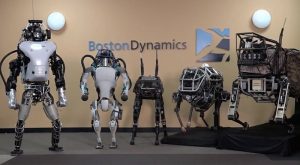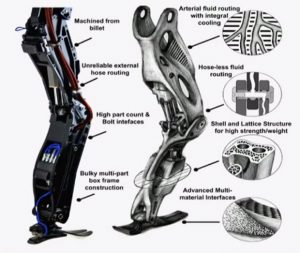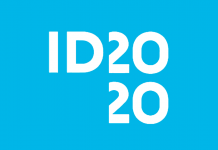Boston Dynamics has an extraordinary technical team of engineers and scientists who seamlessly combine advanced analytical thinking with bold engineering and boots-in-the-mud practicality.
Pride ourselves in building machines that both break boundaries and work in the real world.
Was began as a spin-off from the Massachusetts Institute of Technology, where we developed the first robots that ran and maneuvered like animals. Now we are taking the next step, combining the principles of dynamic control and balance with sophisticated mechanical designs, cutting-edge electronics, and software for perception, navigation, and intelligence.
Boston Dynamics is a leading developer of advanced dynamic robots, including Spot, Atlas, Handle, and others. We love to create innovative machines that combine advanced control systems, sophisticated mechanical designs, on board control and sensing, and extraordinary behavior.
We have a close-knit hard-working team of 80 engineers, scientists and technicians devoted to building the most advanced dynamic robots in the world. If you have excellent technical skills, like to get your hands dirty and want to join our team of robotics rock stars.
The company is a pioneer in the field of robotics and it is one of the most advanced in its domain. Marc Raibert is the company’s president and project manager. He spun the company off from the Massachusetts Institute of Technology in 1992.
On 13 December 2013, the company was acquired by Google X for an unknown price, where it was managed by Andy Rubin until his departure from Google in 2014. Immediately before the acquisition, Boston Dynamics transferred their DI-Guy software product line to VT MÄK, a simulation software vendor based in Cambridge, Massachusetts. On June, 8, 2017, (Gloogle X) Alphabet Inc. announced the sale of the company to Japan’s SoftBank Group for an undisclosed sum.
Changing your idea of What Robots can do, Boston Dynamics builds advanced robots with remarkable behavior: mobility, agility, dexterity … Robots use sensor-based controls and computation to unlock the capabilities of complex mechanisms. Our world-class development teams take projects from initial concept to proof-of-principle prototyping to build-test-build engineering, to field testing and low-rate production:
ATLAS
Atlas is a bipedal humanoid robot primarily developed by the American robotics company Boston Dynamics, with funding and oversight from the United States Defense Advanced Research Projects Agency (DARPA). The 1.8-meter (6 ft) robot is designed for a variety of search and rescue tasks, and was unveiled to the public on July 11, 2013.
Atlas is the latest in a line of advanced humanoid robots we are developing. Atlas’ control system coordinates motions of the arms, torso and legs to achieve whole-body mobile manipulation, greatly expanding its reach and workspace. Atlas’ ability to balance while performing tasks allows it to work in a large volume while occupying only a small footprint.
The Atlas hardware takes advantage of 3D printing to save weight and space, resulting in a remarkable compact robot with high strength-to-weight ratio and a dramatically large workspace. Stereo vision, range sensing and other sensors give Atlas the ability to manipulate objects in its environment and to travel on rough terrain. Atlas keeps its balance when jostled or pushed and can get up if it tips over.
Atlas, The Next Generation
On February 23, 2016, Boston Dynamics released video of a new version Atlas robot on YouTube. The new version of Atlas is designed to operate both outdoors and inside buildings. It is specialized for mobile manipulation and is very adept at walking over a wide range of terrain, including snow. It is electrically powered and hydraulically actuated. It uses sensors in its body and legs to balance, and it uses LIDAR and stereo sensors in its head to avoid obstacles, assess the terrain, help with navigation, and manipulate objects, even when the objects are being moved. This version of Atlas is about 175 cm (5 ft 9 in) tall (about a head shorter than the DRC Atlas) and weighs 180 lb (82 kg).
What’s new, Atlas?
On November 16, 2017, Boston Dynamics released an update video of the Atlas robot to YouTube. In this video Atlas was shown jumping on boxes, turning 180 degrees while jumping and performing a backflip.
On May, 2018, Boston Dynamics released an update video of the Atlas robot to YouTube. Getting some air, Atlas? Published on May 10, 2018 by Boston Dynamics, in this video, Atlas was shown running across grass on an uneven terrain as well as jumping over a log lying on the grass.
________________
Research to Action © 2018 Time Network (Canada)














